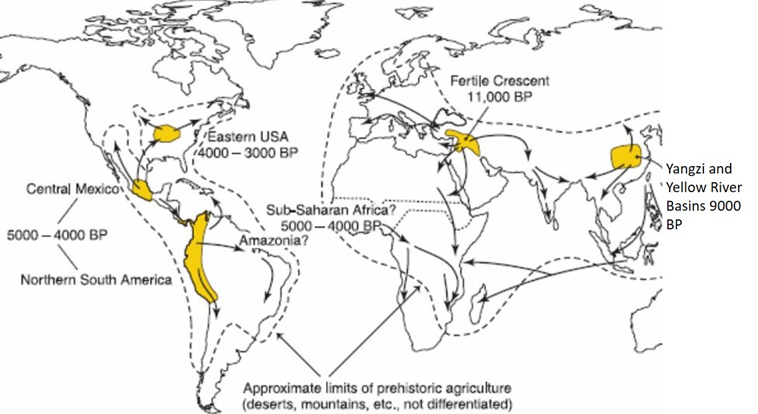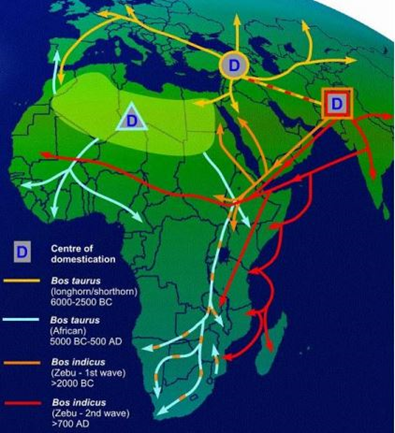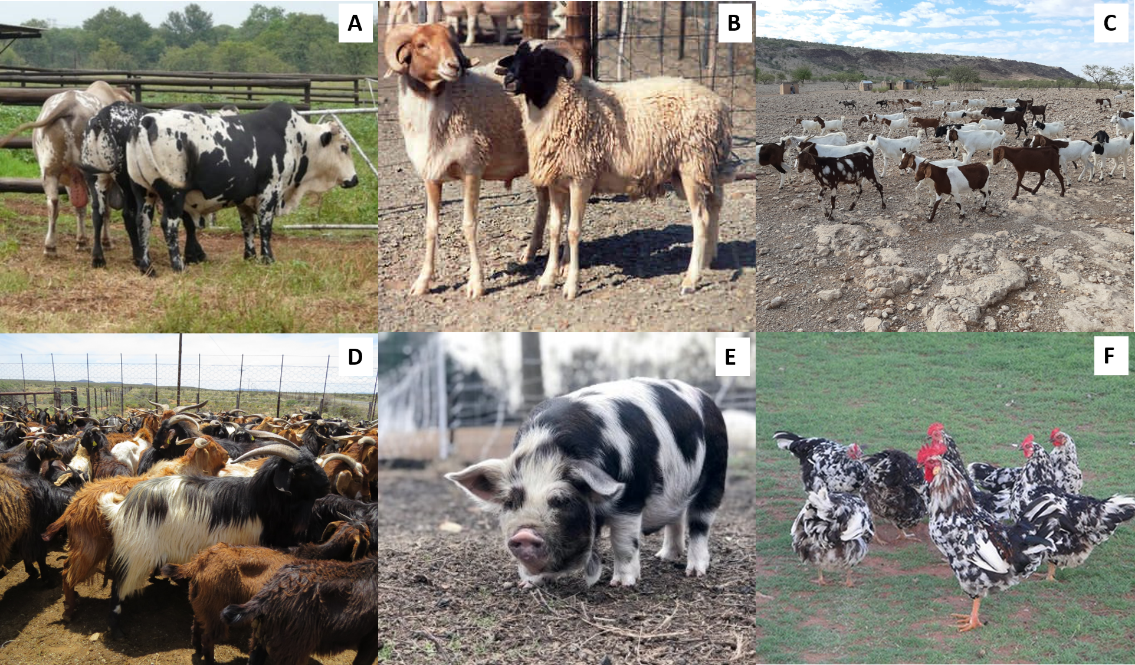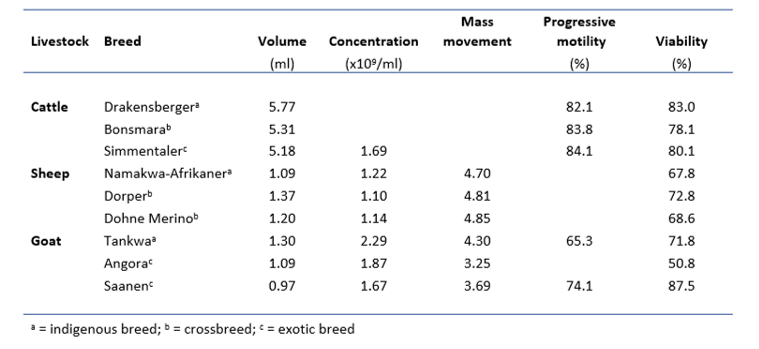Important focus on sperm of indigenous domestic animals in Africa
All domestic animals such as cattle, goats, horses, sheep, dogs and chicken across the globe have been derived from essentially wild animals. In most instances the livestock domestication dates back to many thousands of years (11000 BP) (Fig. 1).

Fig. 1: Map of ancient agricultural areas where domestication seem to have originated in different continents. Modified from Diamond and Bellwood (2003); BP = Before present time.

Fig. 2: The main migration routes of cattle in Africa and Southern Africa. The main species were Bos taurus and Bos indicus (adapted from Graphics unit, ILRI (2006)).
In this blog we concentrate on the indigenous domestic/livestock animals of Africa that originated mainly from the Fertile Crescent (also known as the Cradle of Civilization, including parts of Egypt, Jordan, Lebanon, Palestine, Israel, Syria Turkey and Iran; Fig. 1). Four important questions will be addressed: How did the livestock arrive in the southern parts of Africa; when did this happen; why are these indigenous livestock important (do we need to preserve them); and what are their fertility status with special reference to their semen quality?
Figure 2 shows the major migration patterns of humans/livestock (cattle) to the more southern parts of Africa. It is of interest that the Tsetse fly (causing sleeping sickness, with severe lethal effects on many body systems) formed a barrier just south of the equator to migration of both humans and animals. However, a narrow tsetse-free corridor in the Great Lakes region near Lake Victoria and the Ruwenzori Mountains provided a “Tsetse disease-free pathway” for migration as early as 5000 BC and later migrations (500 AD). There are about 180 breeds of cattle in sub-Saharan Africa of which 150 are indigenous, and similarly there are numerous indigenous breeds of sheep, goats, pigs and chickens in Southern Africa (Table 1).
In most instances, it has been established that indigenous breeds are much more resistant to ecto- and endoparasites, they are heat tolerant, and they can survive on very little water and poor quality feed compared to imported breeds from Europe. These aspects are not only important in terms of breeding for the best characteristics for stock improvement but also for the best survival rate of these animals in rural African communities, often with limited veterinarian support. In South Africa, 40% of livestock are owned by rural communities that form part of subsistence farming systems (raising livestock sufficient for one’s own use, without any surplus for trade).
Unfortunately, only limited information is available on the reproductive status of indigenous livestock in Southern Africa. Moreover, male animals are often the most neglected individuals in a heard, and without screening of testes and semen characteristics it will be impossible to select males to improve livestock production. In this regard, a number of research institutions have contributed to the assessment of semen quality and sperm biology in various indigenous livestock breeds (Fig. 3), including the Agricultural Research Council (Animal Production), University of the Western Cape (Comparative Spermatology Group) and University of Fort Hare (Department of Livestock and Pasture Science).

Fig. 3: Indigenous livestock breeds of South Africa A) Nguni cattle, B) Namakwa-Afrikaner sheep, C) Kunene goats, D) Tankwa goats, E) Kolbroek pig, F) Venda chickens.
Even though some are of the opinion that indigenous breeds should be kept pure and protected, many crossbreeding programmes (using indigenous and exotic breeds) have been established in Southern Africa to try and improve animal production and adaptability to the harsh environment. For instance, the South African Boer goat has been produced by cross breeding and is internationally highly regarded for its many uses in terms of skin, milk and meat. However, it is imperative that the potential fertility of both the indigenous breeds and resulting crossbreeds should be assessed to develop appropriate and sustainable breeding programs. From Table 2 it is clear that indigenous breeds (e.g. Drakensberger cattle, Tanka goat and Namakwa-Afrikaner sheep) have equally good semen characteristics than unrelated crossbreeds or exotic breeds.

Table 2: Comparision of semen characteristics among indigenous, crossbreed and exotic breeds of cattle, sheep and goats.
Several research groups in South Africa are further quantifying semen and sperm functional characteristics in many of these indigenous livestock breeds using SCA computer-aided semen analysis. Recent publications from these groups have shown the value of objective CASA assessments to establish semen characteristics and providing important baseline data for many of these species. Not only do our efforts in this regard assits to predict the potential fertility of indigenous domesticated animals, but it also contributes to the conservation of our unique genetic resources.
Prof Gerhard van der Horst (PhD, PhD)
Senior Consultant
MICROPTIC S.L.
Dr Liana Maree (PhD)
Comparative Spermatology Laboratory
Department of Medical Bioscience, University of the Western Cape, South Africa





Leave A Comment